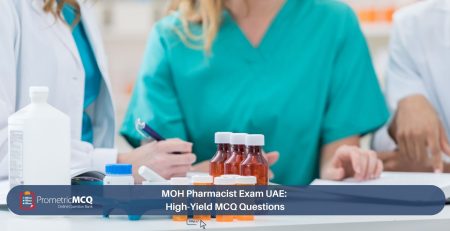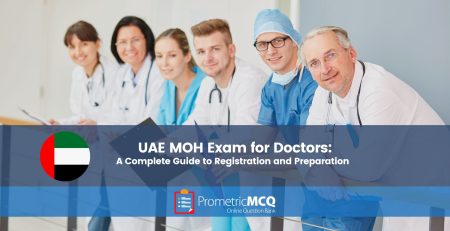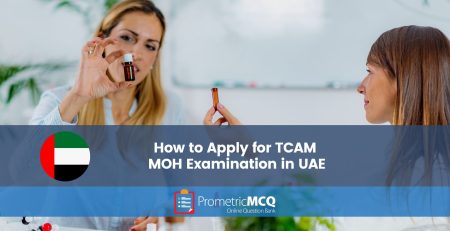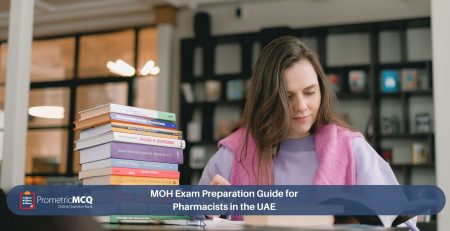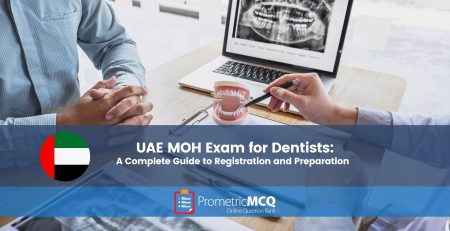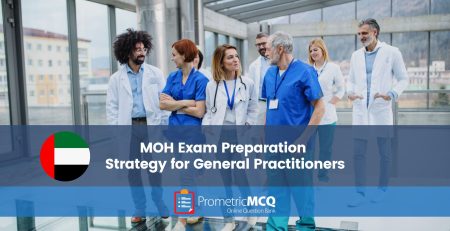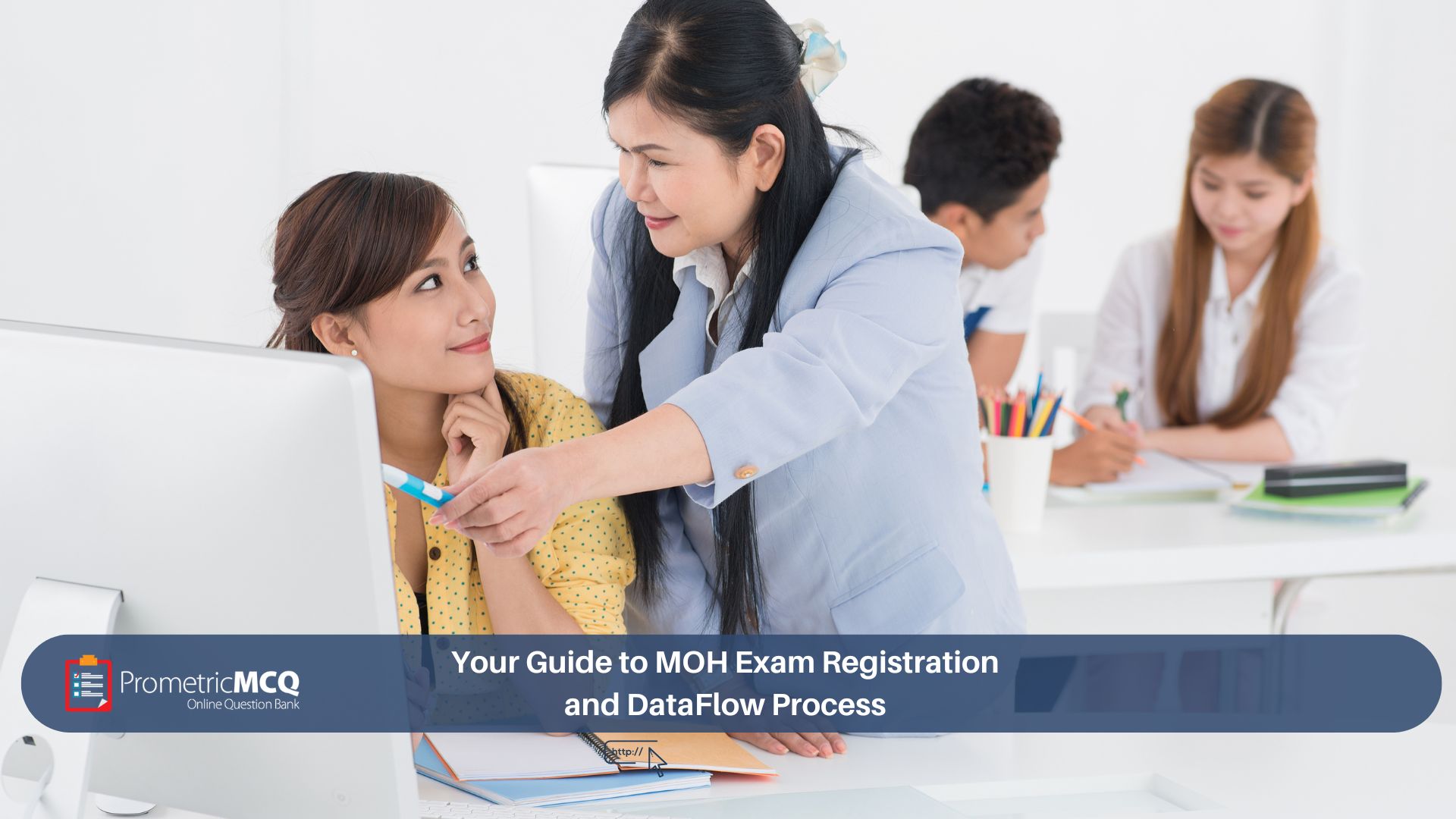
Your Guide to MOH Exam Registration and DataFlow Process
fatima@prometricmcq.com2025-09-24T16:50:37+00:00Table of Contents
ToggleYour Guide to MOH Exam Registration and DataFlow Process
Embarking on a healthcare career in the United Arab Emirates is an exciting prospect, offering access to advanced medical facilities and a unique professional experience. Before you can practice in the Northern Emirates, however, every healthcare professional must navigate a critical two-part administrative journey: the Ministry of Health and Prevention (MOHAP) exam registration and the mandatory credential verification known as the DataFlow Primary Source Verification (PSV) process. This journey, while straightforward in principle, is detailed, document-intensive, and can be daunting for first-time applicants.
Mistakes or omissions in either the registration or DataFlow phase can lead to significant delays, frustration, and even rejection of your application. Understanding each step, preparing your documents meticulously, and knowing what to expect is the key to a smooth and successful process. This is not just about booking an exam; it’s about building a complete professional profile that meets the UAE’s exacting standards for healthcare practitioners.
This ultimate 3000-word guide is your definitive roadmap. We will walk you through every single step of the MOH exam registration and DataFlow process for 2025. From compiling your initial document checklist to understanding the nuances of the MOHAP portal and navigating the complexities of PSV, this article will provide the clarity and confidence you need. We aim to demystify the entire application process for the MOH medical license, ensuring you are perfectly prepared for the administrative journey ahead.
Key Takeaways for a Smooth MOH Registration
- Preparation is Everything: Gather all your required documents *before* starting the online application. This is the single most important step to avoid delays.
- The Process is Sequential: You cannot book your exam until your application is reviewed by MOHAP and your DataFlow PSV process is initiated and linked.
- Accuracy is Non-Negotiable: Ensure that the names and details on all your documents (passport, degrees, licenses) match perfectly. Even minor discrepancies can cause major issues with DataFlow.
- DataFlow is the Longest Phase: The Primary Source Verification (PSV) is often the most time-consuming part of the process. Be patient and proactive in following up.
- Understand the Fees: The total cost is broken down into multiple payments: initial application fee, DataFlow fee, exam fee, and final license issuance fee.
Phase 1: The Pre-Application Document Checklist
Before you even open the MOHAP portal, your first task is to gather and scan a complete set of high-quality documents. Having these ready will make the online application process infinitely smoother. All scans should be clear, in color, and in the required format (usually PDF or JPG).
Essential Documents for All Professionals
- Valid Passport: A clear copy of your passport with at least six months of validity.
- Passport-Sized Photograph: A recent, high-quality photo with a white background.
- Educational Qualifications:
- Bachelor’s Degree Certificate.
- Master’s or PhD Degree Certificate (if applicable).
- All relevant transcripts of records for your qualifications.
- Professional License/Registration: A valid and current medical/professional license from your home country or the country you last practiced in.
- Certificate of Good Standing (CGS): This is a critical document. The CGS must be issued by the medical licensing council/authority of the country you are currently licensed and practicing in. It must be recent, typically issued within the last 3 to 6 months.
- Experience Certificates: Official, signed, and stamped letters from all previous employers for the last 2-3 years (depending on your profession’s requirement). These letters must clearly state your job title, the period of employment (from DD/MM/YYYY to DD/MM/YYYY), and a brief description of your role.
- Log Book for Surgical Specialties: Surgeons and some other specialists will need to provide a log book detailing the procedures they have performed over the last two years.
Phase 2: Navigating the MOHAP Online Registration Portal
Once your documents are in order, you can begin the online application process via the official MOHAP licensing system. The entire journey starts here.
Step 1: Create Your Account
Go to the MOHAP e-services portal. You will need to create a new user account with a valid email address. This email will be used for all official communication, so ensure it is one you check regularly.
Step 2: The Self-Assessment Tool (SAT)
Before you can formally apply, you must complete the SAT. This is an online tool that allows you to check if you meet the basic eligibility criteria for your profession based on your nationality, education, and years of experience. The tool will give you an instant “Eligible” or “Not Eligible” result. If you are eligible, you can proceed to the next step.
Step 3: Completing the Application Form
This is the core of the registration process. You will need to fill in several sections with meticulous accuracy:
- Personal Details: Enter your name, date of birth, nationality, and passport details exactly as they appear on your passport.
- Contact Information: Provide your current address and contact details.
- Educational Details: Enter the details of your qualifications, including the university name, country, and dates of graduation.
- Professional License Details: Add the details of your current and previous professional licenses.
- Work Experience: Detail your employment history. This information MUST match what is on your experience certificates.
Step 4: Uploading Your Documents
You will now be prompted to upload the scanned copies of the documents you prepared in Phase 1. The portal will have specific upload slots for each document type. This is where your organized folder of clearly named files will be a huge help.
Step 5: Application Submission and Fee Payment
After uploading all documents, review your entire application one last time. Once you are satisfied, submit it. You will then be directed to a payment gateway to pay the initial application processing fee (typically around 200 AED). After successful payment, your application status will change to “Under Review” by the MOHAP licensing team.
Phase 3: The DataFlow Primary Source Verification (PSV) Process
This is arguably the most crucial and often longest phase of the entire licensing journey. The MOHAP does not issue a license based on documents alone; they must be independently verified by a third-party company, the DataFlow Group.
What is DataFlow PSV?
Primary Source Verification is the process of authenticating your credentials directly from the issuing source. DataFlow will contact your university, licensing authority, and previous employers to confirm that the documents you submitted are genuine and accurate. This is a mandatory anti-fraud measure that ensures the integrity of the healthcare system in the UAE. For official information, you can visit the DataFlow Group’s official website.
Initiating the DataFlow Process
Once the MOHAP team completes their initial review of your application and finds it complete, they will forward your details to DataFlow. You will receive an email from DataFlow with a link to pay for the PSV report. The fee varies based on the number of documents to be verified but is typically in the range of 900 – 1,300 AED for most professionals.
What Happens During Verification?
- Education: DataFlow contacts the registrar or relevant department of your university/college to confirm your degree, attendance dates, and graduation.
- Licensing: They contact the medical council/authority that issued your license and Certificate of Good Standing to verify their authenticity.
- Experience: This can be the trickiest part. DataFlow contacts the HR departments of your previous employers to verify your employment dates and job title as stated on your experience letters.
Phase 4: Booking and Sitting for the Prometric Exam
Once your DataFlow report is completed and sent back to MOHAP, and they have approved your application, your status on the MOHAP portal will change. You will then be issued an “Eligibility Number.” This number is your key to the final step before licensing: the Prometric exam.
Scheduling Your Exam
With your eligibility number, you can visit the Prometric website, select the MOHAP as the test sponsor, and enter your number to view available exam dates and locations. You can choose a test center in your home country or in the UAE. After selecting a date and time, you will pay the exam fee (around $240 USD, varies by location) directly to Prometric to confirm your booking.
Preparing for the Exam
This is where your clinical knowledge is tested. The administrative part is over; now, you must focus on studying. A structured approach is key. For a deep dive into exam content, refer to our complete guide to MOH Prometric Exam Preparation.
Frequently Asked Questions (FAQs) for MOH Registration & DataFlow
The timeline can vary significantly. A realistic estimate is 2 to 4 months from initial application to receiving your eligibility letter. The MOHAP review may take 2-4 weeks, while the DataFlow process is the most variable part and can take anywhere from 6 weeks to 3 months, depending on how quickly your institutions respond.
The costs are paid in stages. As of 2025, you can expect the total to be roughly:
- Initial MOHAP Application Fee: ~200 AED
- DataFlow PSV Fee: ~900 – 1,300 AED
- Prometric Exam Fee: ~$240 USD (~880 AED)
- License Activation Fee (paid by your employer): ~2,500 – 3,000 AED
These are estimates and can change, so always check the official portals for current fees.
A CGS is a letter from your home country’s medical licensing authority confirming that you are in good professional standing, have no pending disciplinary actions, and are fit to practice. It is a mandatory document that proves your ethical and professional record. It MUST be recent (usually valid for 3-6 months from the date of issue).
This is a serious issue. A “Negative” result (meaning a credential was found to be fake) will lead to rejection and potential blacklisting. An “Unable to Verify” result means the institution did not respond. In this case, DataFlow will ask for your assistance in providing alternative contact details. If it still cannot be verified, MOHAP may reject your application or ask for additional supporting documents.
Yes, license transfers between UAE health authorities are possible without needing to retake the exam, provided you meet certain criteria (e.g., your license is active and in good standing). The process still requires an application on the MOHAP portal and a new DataFlow report to transfer your existing PSV report to MOHAP.
For the initial application and DataFlow process, you typically do not need ministry-level attestation. Clear, scanned copies of the original documents are usually sufficient. However, educational document attestation by the UAE Ministry of Foreign Affairs will be required by your employer for visa and final hiring processes later on.
Be proactive. Contact your university’s registrar or alumni office yourself. Explain the situation, provide them with the DataFlow case number, and ask them to respond to the verification request. You can then provide the contact details of the person you spoke with to your DataFlow case officer.
The eligibility letter is typically valid for one year. Within this period, you must find a job in one of the Northern Emirates and have your employer activate your license. If you do not activate it within a year, the letter will expire, and you may need to retake the exam.
All documents that are not in English or Arabic must be legally translated into English by a certified translator. You must submit both the original document and the certified translation.
Yes, absolutely. The recommended approach is to complete the entire process up to receiving your eligibility letter *before* you start applying for jobs. Most employers in the UAE will only seriously consider candidates who are already “MOH-Eligible.”
Conclusion: Your First Step Towards a Career in the UAE
The MOH registration and DataFlow process is a meticulous and structured pathway designed to uphold the highest standards of healthcare in the UAE. While it demands attention to detail and patience, it is a manageable process for any genuine professional. By following this guide, preparing your documents in advance, and communicating proactively, you can navigate the system efficiently. Completing this administrative journey is the foundational first step that moves you from being an applicant to being an MOH-eligible professional, ready to take the final exam and launch a successful career.
Ready to Take the Final Step? Prepare for the MOH Exam.
Now that you understand the registration process, focus on what truly matters: your clinical knowledge. Our comprehensive question banks are your best tool for success.


